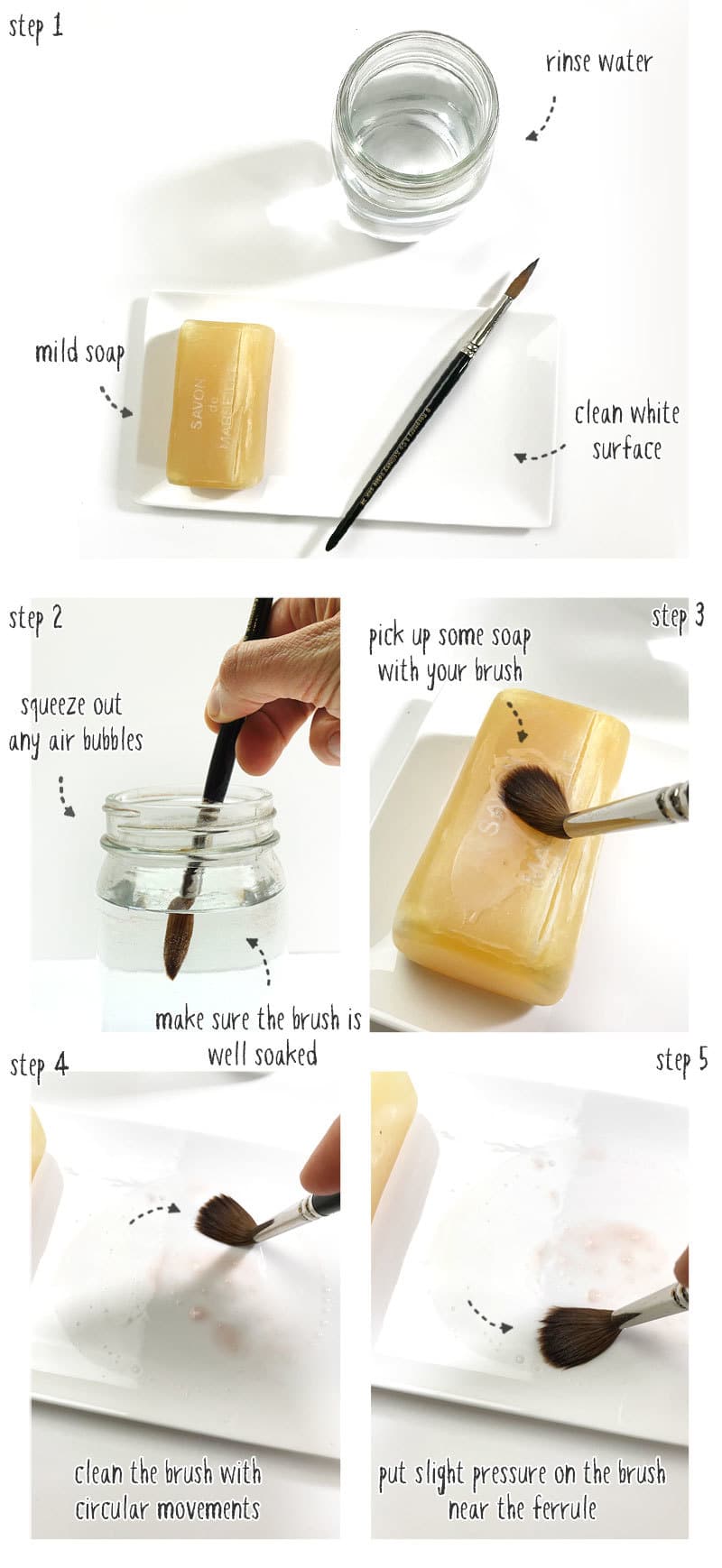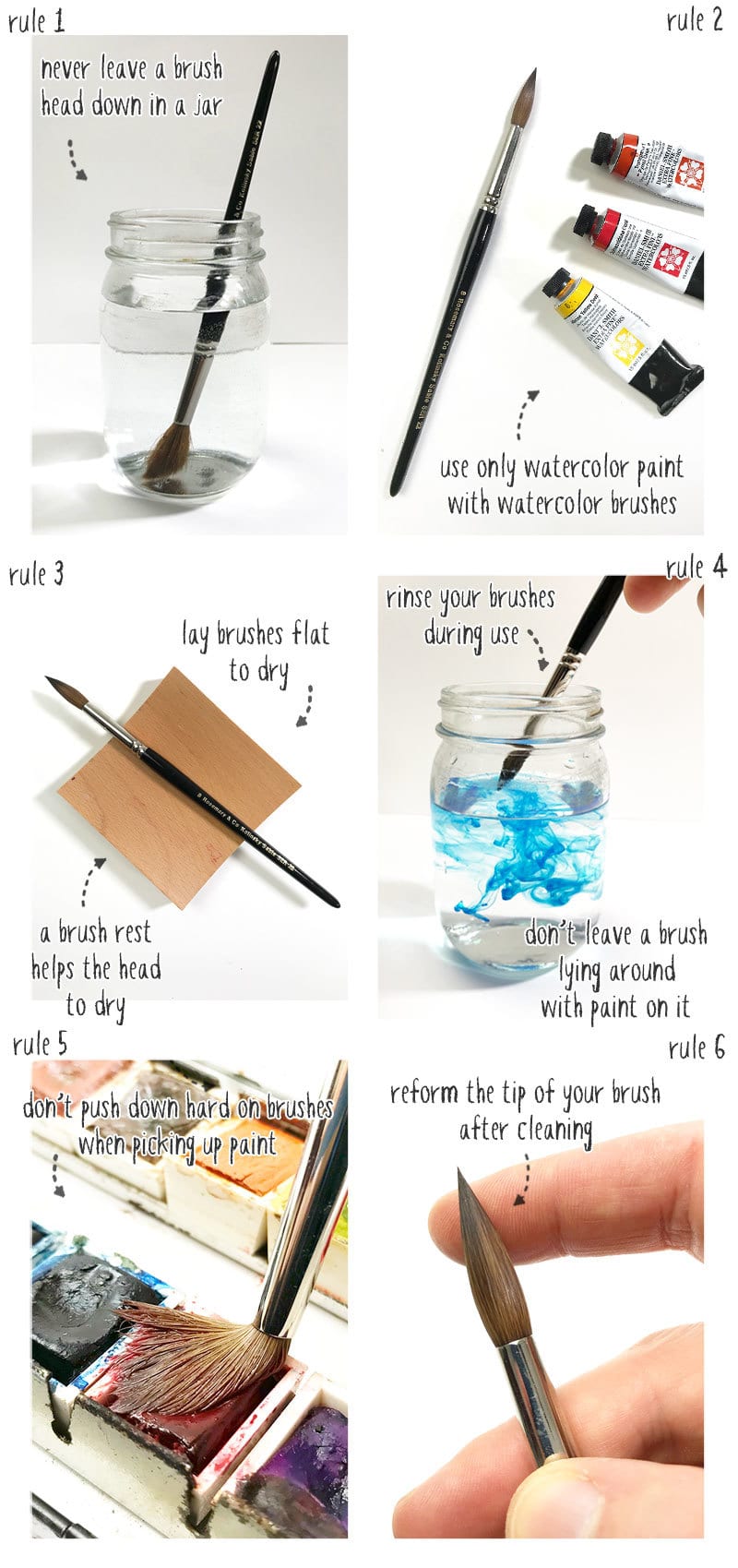How to Clean Watercolor Brushes the Easy Way?
A quick tip when you choose your brushes. Don’t buy brushes where the ferrule isn’t one continuous piece of metal. Some brushes have split ferrules which more easily come loose. The importance of the ferrule is to keep everything in place!
Why you should Clean your Watercolor Brushes
Watercolor brushes are quite unique because of their softness. Better quality brushes use natural hair such as sable or squirrel. This natural hair is fine and delicate and can be damaged. But even synthetic hairs will need cleaning occasionally.
Over time, pigment, paint binders, and other dust and dirt tends to accumulate in the brush hairs, especially near the ferrule. Paint particles are difficult to remove from the base of the brush head near the ferrule, and even if you rinse your brushes regularly you’ll find that paint builds up in this spot.
This build up of particles near the ferrule forces the hairs further apart, and over time can end up deforming the brush.
Furthermore, some paint pigments are more staining than others (the phthalo family of pigments for example). This can discolor the hairs of your brush so much that a good clean with soap is needed from time to time.
How Often to Clean Brushes
You’ll find it isn’t necessary to wash brushes after each painting session.
When you finish painting, simply rinse them well, then reform the tip and leave them to dry on a flat surface.
Depending on how often you use a brush, your cleaning routine should only be occasional. Cleaning too often is pointless. I probably only clean my brushes every three to four months.
Easy Way to Clean Watercolor Brushes
Probably the best way to clean your brushes is using a mild soap. Make sure your soap is of the mild variety. For example something that uses vegetable based oils and contains no additives. You don’t want to use anything too aggressive.
Here’s the method I use when cleaning my brushes:
-
1I like to use a clean white plate or a ceramic mixing tray to work the soap into the hairs. The white surface will let you see how much pigment comes out of the brush during cleaning.
-
2Dip the brush in water and make sure it’s well soaked. You can gently squeeze the brush to make sure there are no air bubbles trapped between the hairs (don’t pull the tuft). Repeat the process of dipping and squeezing until the hairs are thoroughly soaked.
-
3Put a little soap on the brush when its wet, just pick up some soap as if you were picking up paint from your palette.
-
4Rotate the brush in circles so that the brush hairs are pulled along their length. You should not hold the brush vertically and splay the hairs on the surface. You’re trying to follow the natural direction of the brush hairs.
-
5Rinse and repeat. Pick up more soap and push the brush down to apply slight pressure to the hairs near the ferrule. Remember you don’t want to crush the hairs so that they splay outwards a lot because this could deform the head. Turn the handle and work the soap into different sides of the brush.

Commercial Brush Cleaners
I would recommend you try mild soap before any other type of commercial cleaner.
You can find some special brush cleaning products such as the “Masters brush cleaner and preservative”, but keep in mind this kind of product contains some abrasive ingredients.
Did you leave your brush all week soaked with paint? If you forget to clean a brush and it needs recovering, rather than just washing, in this case you could try something like the Masters Brush Cleaner (you can find it here on Amazon).
How to Care for Watercolor Brushes
Watercolor brush care just means picking up some good habits, and avoiding doing anything dumb ! I’m sure you know what I’m talking about… Yes you !
Here are some day to day tips on how to care for your precious brushes so they live long and happy lives!

Brush Storage
If you start to build up a collection of brushes (and I have to admit I’m a sucker for buying nice brushes), you’ll need a good place to store them.
A roll-up brush holder is one of the best alternatives for storage. Traditionally these are made out of bamboo
If you know you’re not going to use a brush for a certain period of time you might consider protecting the hairs with gum arabic. You may have noticed when you buy a new watercolor brush that the hairs are glued together and hard. This is because they are coated with a gum arabic solution to protect them during shipping.
You can use the same stuff to protect your delicate brushes for long periods of storage or when traveling. Check the labels when you buy your gum arabic since sometimes it’s sold in granular form which needs mixing
How to Reshape Watercolor Brushes
The shape of your brushes is possibly more important than their cleanliness! After all, the brush strokes you produce depend heavily on the form and handling quality of your brush
A lot of people underestimate the influence their brushes have on their work. It’s very difficult to obtain decent results with poor quality brushes.
The first rule of thumb is to reshape your brushes after every painting session.
After rinsing the brush, use your fingers to form a pointed tip, by pulling the hairs from the belly towards the tip. There should be no stray hairs pointing out.
But should you find yourself in the unfortunate situation where one of your favorite brushes has lost its shape, do not despair. You may still be able to recover your beloved friend!
This is where gum arabic can come in handy again. As well as protecting brush heads during storage you can also use this substance to try to recover the shape of a deformed brush.
Fully emerge the head of the brush in the liquid gum arabic. Then simply use your fingers to reshape the brush and leave it to dry. The gum arabic will harden, keeping the hairs in shape.
Leave the brush for a few days, then just rinse with water to remove the gum arabic before use.
You can also buy specially formulated products for reshaping brushes such as the Speedball Brush Restoration product
Some people even use hair gel to restore their brush heads! After all, if it’s good enough for your head, it shouldn’t do any hard to your brushes...
Look after your Brushes!
Dry pigment doesn’t really affect the performance of your brushes. But a decent clean every once in awhile will keep your best brushes going for many years.
Cleaning is a worthwhile way to protect the investment you make in expensive watercolor brushes. You ‘ll be better off in the long run. Which do you prefer? Buying new cheap synthetic brushes every year, or caring for an expensive kolinsky sable brush that lasts decades?
